The Sandy Hook Lighthouse, and Battle of Monmouth
The Sandy Hook Lighthouse
On Sunday, March 6, in the pouring rain, we visited the Sandy Hook Lighthouse. There, we met two very nice and helpful tour guides who were kind enough to take us on a tour explaining the lighthouse to us in detail. Did you know there are 91 stairs in the lighthouse? We counted them as we traveled up and up until we reached the top! At the top, there are two lights. They are 1000 watts! You can see them from 19 miles away. Only one light is on and if one light goes out the other would turn on by itself. Bulit in 1674, the light house stands 103 feet tall and was bulit in a spand of 14 months. This wonderful light house has been a prominent landmark for ships approaching Lower New York Harbor. The Sandy Hook Lighthouse is very useful and still is. The light house guided ships through the New York Harbor for more than two centuries! Ever since 1764 when the light house was bulit, this lighthouse has been a beacon for ships. During the American Revolutionary War, British Loyalists defended the Sandy Hook Lighthouse. The Sandy Hook Lighthouse is the oldest standing and operating lighthouse in the United States. This lighthouse is the only surviving lighthouse of the eleven lighthouses built in the thirteen colonies during the colonial period of 1716 to 1771. Most of the people who worked for the Sandy Hook Lighthouse worked for the United States Army, U.S Coast Guard, U.S Lighthouse Service, and the U.S Life-Saving Service. All these people and their families did everything within the peninsula. During the American Revolution, the arrival of the British made the lighthouse a military target.
(FOR MORE INFO ON THE LIGHT HOUSE IN LATER YEARS GO TO THE EXTRA INFORMATION PAGE)
On Sunday, March 6, in the pouring rain, we visited the Sandy Hook Lighthouse. There, we met two very nice and helpful tour guides who were kind enough to take us on a tour explaining the lighthouse to us in detail. Did you know there are 91 stairs in the lighthouse? We counted them as we traveled up and up until we reached the top! At the top, there are two lights. They are 1000 watts! You can see them from 19 miles away. Only one light is on and if one light goes out the other would turn on by itself. Bulit in 1674, the light house stands 103 feet tall and was bulit in a spand of 14 months. This wonderful light house has been a prominent landmark for ships approaching Lower New York Harbor. The Sandy Hook Lighthouse is very useful and still is. The light house guided ships through the New York Harbor for more than two centuries! Ever since 1764 when the light house was bulit, this lighthouse has been a beacon for ships. During the American Revolutionary War, British Loyalists defended the Sandy Hook Lighthouse. The Sandy Hook Lighthouse is the oldest standing and operating lighthouse in the United States. This lighthouse is the only surviving lighthouse of the eleven lighthouses built in the thirteen colonies during the colonial period of 1716 to 1771. Most of the people who worked for the Sandy Hook Lighthouse worked for the United States Army, U.S Coast Guard, U.S Lighthouse Service, and the U.S Life-Saving Service. All these people and their families did everything within the peninsula. During the American Revolution, the arrival of the British made the lighthouse a military target.
(FOR MORE INFO ON THE LIGHT HOUSE IN LATER YEARS GO TO THE EXTRA INFORMATION PAGE)
The Battle of Monmouth
Some say that this battle was one of the most important battles that ever occurred in New Jersey. Even though we are one of the smallest states in America, it proved that we are one of the strongest ones. We fought countless days to try and protect not only New Jersey, but to protect New York City as well. The Battle of Monmouth occurred on June 28th, 1778, and it was between the British army and the American army. Over 21,000 troops were in this battle; 10 thousand from the Americans and 11 thousand from the British. It was over 100 degrees and the men were dropping from dehydration and exhaustion. A lot of people don't know when the Battle of Monmouth ended, but we can estimate that it was a pretty cruel battle lasting around one day. Both the British and the Americans had a hero. The American (just note that there were other heroes) hero was Mary Ludwig Hays McCauley, known as Molly Pitcher. Molly Pitcher started her day by bring cold water to the fallen soldiers. As she was bringing water to a solider, her husband collapsed from his spot at the cannon. She bravely took over his spot for the rest of the day. The British hero was William Howe, he was a commander-in-chief. He led the British forces into the Battle of Monmouth. The British retreated in the middle of the night and the Americans woke up early morning to an emptied battlefield.
Some say that this battle was one of the most important battles that ever occurred in New Jersey. Even though we are one of the smallest states in America, it proved that we are one of the strongest ones. We fought countless days to try and protect not only New Jersey, but to protect New York City as well. The Battle of Monmouth occurred on June 28th, 1778, and it was between the British army and the American army. Over 21,000 troops were in this battle; 10 thousand from the Americans and 11 thousand from the British. It was over 100 degrees and the men were dropping from dehydration and exhaustion. A lot of people don't know when the Battle of Monmouth ended, but we can estimate that it was a pretty cruel battle lasting around one day. Both the British and the Americans had a hero. The American (just note that there were other heroes) hero was Mary Ludwig Hays McCauley, known as Molly Pitcher. Molly Pitcher started her day by bring cold water to the fallen soldiers. As she was bringing water to a solider, her husband collapsed from his spot at the cannon. She bravely took over his spot for the rest of the day. The British hero was William Howe, he was a commander-in-chief. He led the British forces into the Battle of Monmouth. The British retreated in the middle of the night and the Americans woke up early morning to an emptied battlefield.


